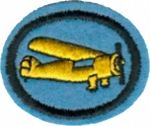Difference between revisions of "AY Honors/Airplane Modeling/Answer Key/es"
m (FuzzyBot moved page Adventist Youth Honors Answer Book/Arts and Crafts/Airplane Modeling/es to Respuestas para la especialidad JA de Aeromodelismo without leaving a redirect: Part of translatable page "Adventist Youth Honors Answer Book/Arts and Crafts/Airplane Modeling") |
|
(No difference)
| |
Revision as of 05:59, 13 December 2020
| Aeromodelismo | ||
|---|---|---|
| Asociación General
|
Destreza: 1 Año de introducción: 1944 |
|
Requisitos
|
La especialidad de Aeromodelismo es un componente de la Maestría Artesanía. |
1. Construir y volar con éxito un avión de un kit de madera de balsa y papel, que sea propulsado por una banda de goma o por gas.
2. Construir un planeador con madera de balsa de un modelo prefabricado y observar sus características de vuelo en relación a la variable posición de las alas.
3. Hacer y volar con éxito 2 diferentes estilos de aviones utilizando hojas de papel de entre 20 centímetros y 35 centímetros de ancho y largo.
4. Definir, ubicar y explicar el uso de los siguientes elementos básicos:
a. Fuselage
The elongated body or frame of an airplane, any kind of frame or body. The central body of an airplane that is designed to accommodate the crew and passengers (or cargo).
b. Wing
Any surface used primarily for supporting an airplane inflight by forward motion.
c. Aileron
Ailerons are movable control surfaces that are present on the trailing edge of both the right and left wings of a plane. Each surface moves in opposite directions enabling a plane to roll right or left. For a plane to roll to the left, the left wing aileron moves upwards while the aileron on the right wing moves downwards.
d. Rudder
This is the term used to describe the part of the tail that moves back and forth. This movement causes the tail of a plane to move which then turns the plane.
e. Horizontal stabilizer
The horizontal "mini wing" at the tail section of the airplane. The elevator is attached to the horizontal stabilizer with hinges.
f. Strut
A diagonal brace going from the fuselage to the bottom of the wing consisting of a bar or rod used to support the wing on the airplane.
g. Cockpit
Compartment where the pilot sits while flying the aircraft.
h. Engine
The source of power to turn the propeller or turbines and generate thrust. Can be an internal combustion engine, jet engine, or in the case of an airplane model a rubber band engine.
i. Landing gear
An undercarriage that supports the weight of the plane when it is on the ground.
j. Propeller
The mechanical device attached to the engine that rotates to push against air and create thrust.
k. Dihedral
Dihedral is where the right and left wing tips are higher than the fuselage. More dihedral generally means that a plane will be more stable in the air, but will be more difficult to turn. Most planes require a bit of dihedral to fly well.
l. Timón de profundidad
m. Propulsión
n. Mandos de vuelo
o. Cola en V
- Categoría: Tiene imagen de insignia
- Adventist Youth Honors Answer Book/Honors/es
- Adventist Youth Honors Answer Book/es
- Adventist Youth Honors Answer Book/Skill Level 1/es
- Categoría: Libro de respuestas de especialidades JA/Especialidades introducidas en 1944
- Adventist Youth Honors Answer Book/General Conference/es
- Adventist Youth Honors Answer Book/Arts and Crafts/es
- Adventist Youth Honors Answer Book/Arts and Crafts/Primary/es
- Adventist Youth Honors Answer Book/Artisan Master Award/es
- Adventist Youth Honors Answer Book/Stage 0/es

